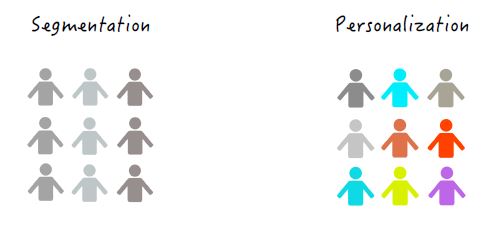With the automation of marketing processes, marketers today rely heavily on intelligent segmentation by discipline, industry or geography. But what is the next step? How can your marketing team do a better job of targeting the right audience? The answer is marketing personalization.
At the arrival of this news, many marketers exclaim, “Wait! I thought I was already using marketing personalization. Wasn’t I?”
The short answer is no. Segmentation is knowing something about a group of people—typically, it’s their tendencies or behaviors derived from averages and means within somewhat homogenous groups.
Personalization is knowing something about a specific individual and usually involves inferring about his or her interests in real-time. Hence, personalization is not the same as segmentation. So, you’re probably not using personalization, even if you thought you were.
 The follow-up question is typically, “Well, what else don’t I know?”
The follow-up question is typically, “Well, what else don’t I know?”
In response, here are five facts you need to know about personalization:
- Personalization helps marketers boost engagement and conversions, but it can also help them better understand the buyer journey. For example, our customers learn that up to 40 percent of conversions take place on pages without any forms
- An Adobe study recently reported that marketers cite personalization as the most important capability required for marketing in the future. As such, you should consider existing tools for personalization (most likely software as a service), as they provide solutions to the top two reasons marketers gave for not implementing “dynamic personalized content”: complexity of systems (50 percent) and access to real-time data (46 percent).
- Data privacy is an issue—that’s for sure—but that’s truer for marketers than it is for the audience. Fourth-five percent of marketers cite this as a main reason for not moving ahead with personalization. However, most people (57 percent) are OK with providing personal information on a website, as long as it’s for their benefit and being used in responsible ways. (Source: Janrain)
- Personalization is often referred to as one-to-one marketing, as it focuses on the individual, but it does require the ability to analyze large amounts of data and act on it in real-time. This is why it is simply impossible to personalize the online experience manually, so don’t try. But…
- You can combine personalization and segmentation very effectively from another angle: segmenting your content into groups and letting personalization tools choose the most relevant content for each visitor. This is especially effective for companies that have just a few products and need to cater to different buying personas.
Segmentation and personalization are different aspects (some would say different generations) of online marketing. Together, they can deliver a very potent punch of relevant information to website visitors. As with everything else in online marketing, giving it a try is probably worth your time, but make sure you know what you want to get out of it before you start testing and implementing.
